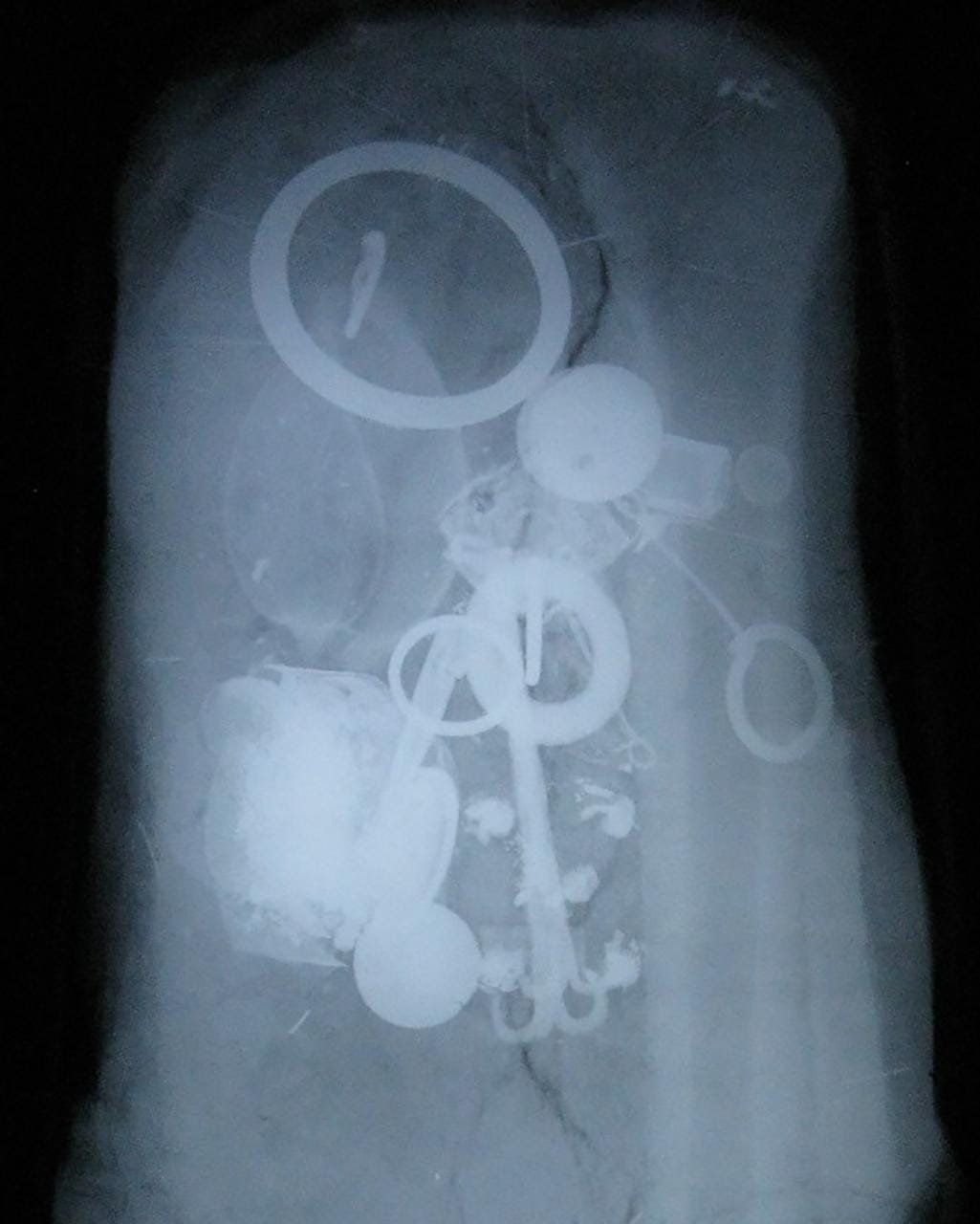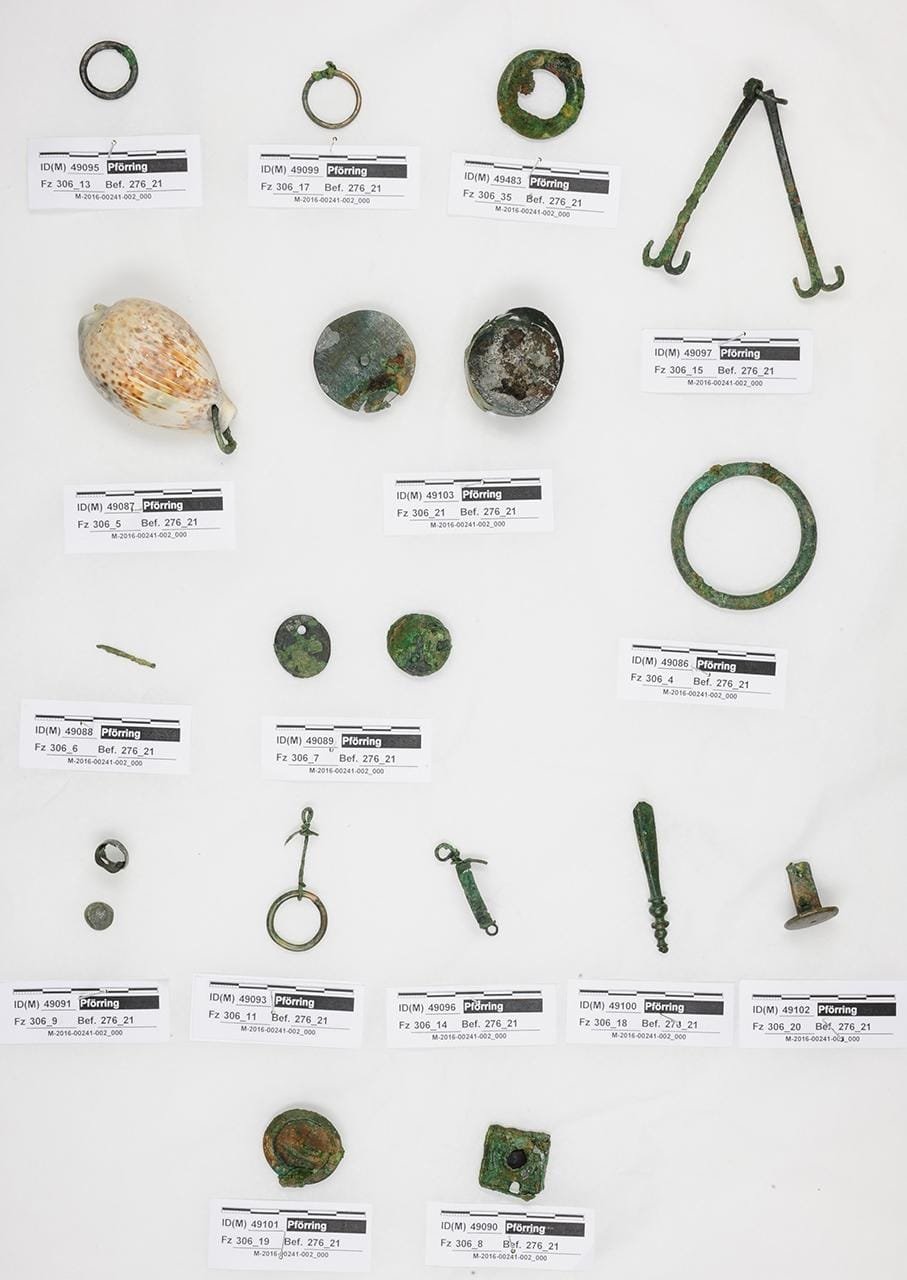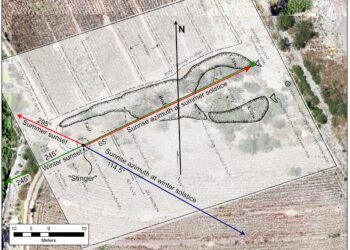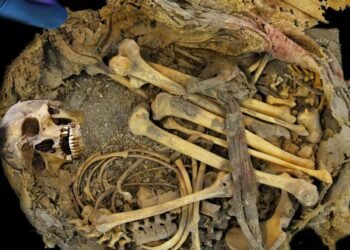In 2016, archaeologists in Pförring, Bavaria, unearthed a 1,500-year-old burial site containing a remarkable collection of artifacts belonging to a young woman from the first half of the 5th century.

This discovery, long puzzling researchers, has recently been better understood thanks to modern restoration and analysis techniques. The collection of items found on the woman’s left thigh, which includes coins, keys, rings, and a decorated walnut pendant, was initially thought to be mere grave goods. However, experts now believe these objects had a deeper symbolic and possibly spiritual significance.
Among the items found were two bronze keys, a bone needle case, several bronze rings, three perforated Roman coins, a decorative disc with a glass inlay, the shell of a sea snail, and the walnut pendant, which was adorned with bronze bands. The objects were connected by leather straps, suggesting they might have been worn as a belt pendant.

This ensemble has drawn comparisons to the modern Bavarian charivari—a chain decorated with coins, talismans, and jewelry, traditionally worn on lederhosen during events such as Oktoberfest. Though the charivari originated in the Napoleonic era, the similarities between the modern accessory and the Pförring find have led scholars to speculate about possible symbolic connections between the two.

Professor Mathias Pfeil, General Conservator of the Bavarian State Office for the Preservation of Monuments, stated that the find “offers a unique glimpse into the culture along the Danube Limes and the significance attributed to certain objects, which were transformed into powerful symbols and talismans.”
The Danube frontier, known as the Limes, was part of the Roman Empire’s defensive line in the province of Raetia, which bordered the river and served as a crucial communication and transportation route. The region, occupied by Roman settlers and local populations, was strategic in protecting against incursions from Germanic tribes.

The most intriguing object in the collection is the walnut-shaped pendant. In ancient times, walnuts were associated with fertility, abundance, and magical protection. The pendant, encased in bronze bands, may have served as a talisman to protect the woman in the afterlife. This rare use of a walnut as a decorative item, combined with the symbolic nature of the other artifacts, suggests that the ensemble was not merely a fashion accessory but likely held significant personal or spiritual meaning.
Experts believe that the collection reflects both the cultural environment of the deceased and the Roman influence on the region during late antiquity. While it is unlikely that the Pförring find can be considered a direct ancestor of the modern charivari, the similarities are unmistakable. Both serve as status symbols and as amulets for protection.
Though discovered in 2016, it is only now, with advanced restoration techniques, that archaeologists can fully appreciate the intricate craftsmanship and meaning behind this collection of objects. The Pförring discovery reveals the personal life and status of a young woman from the 5th century, as well as the broader cultural and symbolic practices of the Roman Empire during its waning years along the Danube frontier.
Bavarian State Office for the Preservation of Historical Monuments























Anyone else notice the two (three if you count both grappling hooks) implements of war?!? I mean specifically the grappling hooks and what appears to be a war club!
Also the item just to thr right of the club looks like the reciever end of a two part pressure rivet!
We have similar hardware today. The reciever is a head like a tack with a small hollow tube either worked into it or braised on it, and the insert is the same type of head with a pin that fits into the reclever. And pressed together with some kind of lever tool or struck against a hard surface with a hammer crushes the pin and reciever together to sandwich two pieces of cloth or small plate mail to the cloth!
I know they riveted battle clothing to such things, but did they use pressure rivets or just peen solid rivets? I need to do some research to find out!
To be honest it looks like a toolbelt that women often used daily. Things to measure or mend, valuables, keys, signats, etc… It would be hung at the waist, at hand when needed.
I agree. It looks like a chatelaine.
Very impressive. To me when I look I see Art..and I wonder where minds were during making of tools. And style.
It seems very strange to me that she would be buried with the walnut pendant and the seashell both witch are signs of life and abundance, the walnut being a sign of fertility, I would like to know if this is a common burial practice or was she buried by someone other than her people 🤔
Just a thought, Given that the grave is that of a lady (female), the so called “grappling hooks”?? to me look as though they could be used as “hair pins, cloths pins”. Also, the so called mini “war club” looks a lot like a part of a “mini mortar and pedestal” most likely utilized by females of the age for crushing small seeds, herbs, flowers etc. possibly for “make -up”, or “arts”., as for the square piece with the hole and the small button headed peg found next to it, looks like the peg would fit nicely into the center of the square piece, sort of like our modern Levi riveted jeans, Due to the lack of these types of items found in the grave, Such as items typically found in females graves throughout the ages e.g. (hair/cloths pins, small make-up items, like Mortars and Pedestals) Question; Would a female be carrying a mini “war club?” one that she’s probably been or seen people threatened with at least once during her short time alive? The so called “club” looking object combined with that small “container-and-lid” looking objects also found along side in the grave, would suggest a strong possibility that the objects were actually functioning tools belonging to a female that utilized them as such. (Garments pegs/pins, hair-pins, Make-up tools) it’s possible, maybe forensics can establish whether or not the tools or items have trace amounts of any kind of organic /non-organic elements still present. Just a thought.